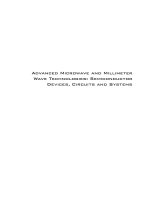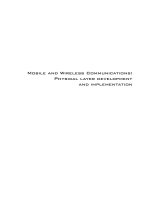Aircraft Design: Synthesis and Analysis - part 1 doc
Bạn đang xem bản rút gọn của tài liệu. Xem và tải ngay bản đầy đủ của tài liệu tại đây (8.8 MB, 53 trang )
Aircraft Design:
Synthesis and
Analysis
Aircraft
Design:
Synthesis and
Analysis
Contents
0. Preface
0.1 Instructions
0.2 General References
1. Introduction
1.1 Historical Notes
1.1.1 Aerodynamics
History
1.1.2 Boeing History
1.1.3 Airbus History
1.1.4 Invention of the
Airplane
1.2 Aircraft Origins
1.2.1 New Aircraft
Development
1.2.2 The Airline
Industry
1.3 Future Aircraft
1.4 References
2. The Design
Process
2.1 Market Determination
2.2 Design Requirements
and Objectives
2.3 Exercise 1: Design
Requirements
2.4 Design Optimization
2.5 Computational
Methods
3. Fuselage Layout
3.1 Cross Section Design
3.1.1 Exercise 2: Cross
Section
3.2 Fuselage Shape
3.2.1 Exercise 3:
Aircraft Design:
Synthesis and Analysis
Preface
About AA241
This material is based on course notes for the class AA241A and B, a graduate level course in aircraft
design at Stanford University. The course involves individual aircraft design projects with problem sets
and lectures devoted to various aspects of the design and analysis of a complete aerospace system.
Students select a particular type of aircraft to be designed and, in two academic quarters, define the
configuration using methods similar to those used in the aircraft industry for preliminary design work.
Together with the vehicle definition and analysis, basic principles of applied aerodynamics, structures,
controls, and system integration, applicable to many types of aerospace problems are discussed. The
objective of the course is to present the fundamental elements of these topics, showing how they are
applied in a practical design.
About the Web Version of These Notes
This internet-based version of Aircraft Design: Synthesis and Analysis is an experiment. It is the
forerunner of a new type of textbook whose pages may be distributed throughout the world and
accessable via the world-wide-web. The text will be evolving over the next few months; new items will
be added continually.
This may turn out to be a true "Hitchhiker's Guide To Aircraft Design" if people are interested in
contributing. You are welcome to send revisions, suggestions, pictures, or complete sections. I will
review them and consider including them (with credits) where appropriate. Send submissions ( in html,
gif, or jpeg form) to Ilan Kroo.
Why a Digital Textbook?
There are several reasons for using this format for the course notes:
● They are easily updated and changed important for aircraft design so that new examples and
methods can be added.
● Analysis routines can be built into the notes directly. The book permits you to build up a design as
you progress through the chapters.
● The format permits easy access to information and organizes it in a way that cannot be done in
hardcopy.
● It is inexpensive to include color pictures and video.
● It is possible, by providing just a couple of custom pages, to tailor the textbook for a particular
course. If the material on supersonic flow is not appropriate for the class, a new outline and
contents page may be created that avoids reference to that material.
About the Authors
Ilan Kroo is a Professor of Aeronautics and Astronautics at Stanford University.
He received a degree in Physics from Stanford in 1978, then continued graduate
studies in Aeronautics, leading to a Ph.D. degree in 1983. He worked in the
Advanced Aerodynamic Concepts Branch at NASA's Ames Research Center then
returned to Stanford as a member of the Aero/Astro faculty. Prof. Kroo's research
in aerodynamics and aircraft design has focussed on the study of innovative
airplane concepts and multidisciplinary optimization. He has participated in the
design of high altitude aircraft, human-powered airplanes, America's Cup
sailboats, and high-speed research aircraft. He was one of the principal designers
of the SWIFT, tailless sailplane design and has worked with the Advanced
Research Projects Agency on high altitude long endurance aircraft. He directs a research group at
Stanford consisting of about ten Ph.D. students and teaches aircraft design and applied aerodynamics at
the graduate level. In addition to his research and teaching interests, Prof. Kroo is president of Desktop
Aeronautics, Inc. and is an advanced-rated hang glider pilot.
Richard Shevell was the original author of several of these chapters. He worked in aerodynamics and
design at Douglas Aircraft Company for 30 years, was head of advanced design during the development
of the DC-9 and DC-10, and taught at Stanford University after that for 20 years. To a large extent, this is
his course.
Instructions
This version of Aircraft Design: Synthesis and Analysis is intended for use with Netscape Navigator,
version 4.0 or later, or with Microsoft's Internet Explorer, version 4.0 or later. The text makes use of
frames, javascript, and Java, so be sure your browser supports this and that these features are enabled.
Please see the help available from Netscape or Microsoft for using the browser software.
Navigating
To navigate through this text, click on the topic shown in the frame to the right. The browser remembers
whare you have been, and sections that you have already visited are displayed in another color. To reset
the history information so that all section names are displayed in the default color, follow the browser
instructions on clearing the history or disk cache.
We have minimized the use of embedded hypertext links as we have found this often confuses students
trying to navigate through a textbook. It also makes it difficult to expand or delete sections to form a
custom version of the text (see below). This means that most of the navigation is done through the table
of contents. A rather complete table of contents can also be found in the prefatory information and active
links on this page will also work. Some hypertext links are used, but most are restricted to single level
pages with additional detail, as might be found in an extended footnote.
Printing
Most pages in the text can be printed directly from the browser. Make sure to specify color or greyscale
printing for improved photo images. The chapter and section numbers are generated by javascript on the
fly, and some browsers will omit the numbers from the printed heading name. Also, at the time of this
release, no platform-independent printing strategy is available for java applets. To print the results from
one of the interactive computations, you may need to capture the screen image and send it to the printer.
This can be done on most platforms, but the approach depends on the operating system.
Frames
If you are confused by navigating with frames, please read the material available from the Netscape or
Microsoft sites and be patient. Many people do not like frame-based pages, but after years of
experimentation, we have found that this really does seem to work best for this text. Let us know if you
have other ideas.
You may resize the frames to make more or less of the table of contents visible. The best size depends on
the size of your monitor and your personal preferences experiment. Also, because you may want to
make as much of the content visible in the available screen space, we recommend that you hide some of
the toolbar or directory areas at the top of the screen. You can do this from the browser preferences or
options menus.
Trouble-Shooting
If you have other difficulties, please check the Desktop Aeronautics web site:
for further suggestions and any fixes that may be posted.
General References
Kuchemann, J., Aerodynamic Design of Aircraft, Pergammon Press, 1982.
Shevell, R.S., Fundamentals of Flight, Prentice Hall, 1983.
Schlichting H. and Truckenbrodt E., Aerodynamics of the Airplane, McGraw-Hill, 1979.
Torenbeek, E., Synthesis of Subsonic Airplane Design, Delft Univ. Press, 1982.
Taylor, J., ed., Jane's All the World's Aircraft, Jane's Publishing Inc., Annual.
Articles in Aviation Week & Space Technology, McGraw-Hill.
Raymer, D., Aircraft Design-A Conceptual Approach, AIAA, 1992.
Roskam, J., Aircraft Design, Published by the author as an 8 volume set, 1985-1990.
Nicolai, L.M., Fundamentals of Aircraft Design, METS, Inc., 6520 Kingsland Court, San Jose, CA,
95120, 1975.
Stinton D., The Design of the Airplane, van Nostrand Reinhold, New York, 1983.
Thurston D., Design for Flying, Second Edition, Tab Books, 1995.
Aircraft Design Information Sources by W.H. Mason at VPI is an excellent annotated bibliography on
many aspects of aircraft design and is available on the web.
Introduction
This chapter includes a discussion of the history of aircraft development, some notes on aircraft origins
(how a new aircraft comes to be developed), a few ideas on future aircraft types and technology, and a
number of references and links to related sites.
● Historical Notes
● Aircraft Origins
● Future Aircraft
● References
History of Transport Aircraft and
Technology
There are numerous interesting books on the history of aircraft development. This section contains a few
additional notes relating especially to the history of aircraft aerodynamics along with links to several
excellent web sites. Among the conventional references of interest are the history section in Shevell's
Fundamentals of Flight and John Anderson's book on the history of aerodynamics (see References).
Here are some additional links with aeronautical history.
● Some historical notes on the history of aircraft and aerodynamics.
● Boeing History
● Airbus History
● Milestones in the History of Flight (Air and Space Museum)
● Invention of the Airplane
● The Octave Chanute Pages
● AIAA 1903 Wright Flyer Project
● The Wright Brothers
References
History
General History:
Anderson, J., A History of Aerodynamics: And Its Impact on Flying Machines, Cambridge Univ Press,
1997.
Dalton, S., The Miracle of Flight, McGraw-Hill, 1980.
Kuchemann, D., Aerodynamic Design of Aircraft, A Detailed Introduction to the Current Aerodynamic
Knowldge,1978.
Shevell, R., Fundamentals of Flight, Prentice Hall, 1983.
Taylor, J., Munson, K. eds., History of Aviation, Crown Publishers, 1978.
Early Development:
Chanute, O., Progress in Flying Machines, The American Engineer and Railroad Journal, N.Y., 1894.
Now available as a Dover paperback.
Lilienthal, O., Birdflight as the Basis of Aviation, first published in German 1889, translation published
by Longmans, Green, & Co., London 1911.
Proceedings of the International Conference on Aerial Navigation, Chicago, The American Engineer and
Railroad Journal, N.Y., 1893.
Aircraft Origins
Newhouse, J., The Sporty Game, Wiley, 1984.
Sabbagh, K., 21St-Century Jet : The Making and Marketing of the Boeing 777, Scribner, 1996.
Irving, C., Wide-Body: The Triumph of the 747, William Morrow and Company, Inc., N.Y., 1993.
Related Web Sites
British Airways overview of the airline industry
Historical Notes
It was not long ago that people could only dream of being able to
fly.
The dream was the subject of great myths and stories such as that of
Icarus and his father Daedalus and their escape from King Minos'
prison on Crete. Legend has it that they had difficulty with structural
materials rather than aerodynamics.
A few giant leaps were made, with little forward progress. Legends
of people attempting flight are numerous, and it appears that people
have been experimenting with aerodynamics for thousands of years.
Octave Chanute, quoting from an 1880's book, La Navigation
Aerienne, describes how Simon the Magician in about 67 A.D.
undertook to rise toward heaven like a bird. "The people assembled
to view so extraordinary a phenomenon and Simon rose into the air
through the assistance of the demons in the presence of an enormous
crowd. But that St. Peter, having offered up a prayer, the action of
the demons ceased "
(Picture from a woodcut of 1493.)
In medieval times further work in applied aerodynamics
and flight were made. Some rather notable people climbed
to the top of convenient places with intent to commit
aviation.
Natural selection and survival of the fittest worked very
effectively in preventing the evolution of human flight.
As people started to look before leaping, several
theories of flight were propounded (e.g. Newton) and
arguments were made on the impossibility of flight.
This was not a research topic taken seriously until
the very late 1800's. And it was regarded as an
important paradox that birds could so easily
accomplish this feat that eluded people's
understanding. Octave Chanute, in 1891 wrote,
"Science has been awaiting the great physicist, who,
like Galileo or Newton, should bring order out of
chaos in aerodynamics, and reduce its many
anomolies to the rule of harmonious law."
(A Galapagos hawk Photo by Sharon Stanaway )
Papers suggested that perhaps birds and insects used some
"vital force" which enabled them to fly and which could not
be duplicated by an inanimate object. Technical meetings
were held in the 1890's. The ability of birds to glide without
noticeable motion of the wings and with little or negative
altitude loss was a mystery for some time. The theory of
aspiration was developed; birds were in some way able to
convert the energy in small scale turbulence into useful
work. Later this theory fell out of favor and the birds' ability
attributed more to proficient seeking of updrafts. (Recently,
however, there has been some discussion about whether
birds are in fact able to make some use of energy in small
scale air motion.)
The figure here is reproduced from the 1893 book, First
International Conference on Aerial Navigation. The paper is
called, "The Mechanics of Flight and Aspiration," by A.M.
Wellington. The figure shows the flight path of a bird
climbing without flapping its wings. Today we know that the
bird is circling in rising current of warm air (a thermal).
Designs were made before people had the vaguest idea about how aircraft flew. Leonardo Di Vinci
designed ornithopters in the late 1400's, modeled on his observations of birds. But apart from his work,
most designs were pure fantasy.
The first successes came with gliders. Sir George Cayley wrote a book entitled "On Aerial Navigation" in
1809. He made the first successful glider in 1804 and a full-size version five years later at the age of 36.
For many years thereafter, though, aeronautics was not taken seriously, except by a small group of
zealots. One of these was William Henson who patented the Aerial Steam Carriage, shown here, in 1842.
The aircraft was never built, but was very well publicized (with the idea of raising venture capital). Both
the design and the funding scheme were ahead of their time.
Some rather ambitious designs were actually built. The enormous aeroplane built in 1894 by Sir Hiram
Maxim and shown below, weighed 7,000 lbs (3,200 kg) and spanned over 100 ft (30 m).
In Germany in the 1860's Otto Lilienthal took a more conscientious approach with tests on a whirling
arm, ornithopter tests suspended from a barn, and finally flight tests of a glider design. He studied the
effect of airfoil shape, control surfaces, propulsion systems, and made detailed measurements of bird
flight. His book,
"Birdflight as the Basis of Aviation" was an important influence on later pioneers.
This was one of Lilienthal's last flights. He was killed in 1896 by a gust-induced stall too near the
ground.
From Lilienthal's first flights in the 1890's, to the Wright brother's glider flights and powered aircraft,
evolution was quick.
Orville Wright soars a glider in 50 mi/hr (80 km/hr) winds for 10 minutes at Kitty Hawk, Oct. 24, 1911.
This was one of the first applications of a aft horizontal tail on the Wright aircraft. From Aero Club of
America Bulletin, Jan. 1912.
The first 'Aerial Limousine', 1911. "The limousine has doors with mica windows and seats for four
persons fitted with pneumatic cushions, the pilot seats in front. A number of flights have been made, with
and without passengers, with entire success."
The Boeing 777, Courtesy Boeing Commercial Airplane Group.
It is truly amazing how quickly this has happened: we tend to think of the dawn of flight as something
from Greek mythology, but it has been only about 100 years since people first flew airplanes.
Of course other things happen quickly too. When the 747 was designed calculators were big whirring
contraptions which sat on desks and could not do square roots. The earlier transports, still flying today,
were designed when calculators were women who worked the computing machines.
The picture below shows the computational grid for a modern calculation of the flow over 737 wing with
flaps and slats deployed.
Image from NASA Ames Research Center
The revolution in computing has changed the way we do computational applied aerodynamics, but we
still utilize a variety of methods. Computation, ground-based testing, and finally, flight tests.
The plot shows the computer power required to perform the indicated calculations in about 15 minutes
using 1985 algorithms. Using more modern supercomputers and now, parallel machines, this time is
dropping dramatically. Yet, we are still a long way from routine applications of direct Navier-Stokes
simulations or LES.
The Cray C916 Supercomputer
Projects such as NASA's Numerical Aerodynamic Simulation program continue to develop simulation
software that takes advantage of recent advances in computer hardware and software.
In this class we will talk about the methods used to compute aerodynamics flows. We will use simple
methods on personal computers and design airfoil sections. We will analyze wings and talk about the
elements of wing design. We will be talking about fundamental concepts that can be demonstrated with
simple programs but which form the basis for modern computational methods. We will discuss how these
methods work, what they can and cannot do. We will use results from analytical studies, wind tunnel
tests, and CFD to discuss wing and airplane design.
While we discuss aircraft a great deal, the concepts and methods are relevant to a wide range of
applications: Weather prediction, boat design, disk drive aerodynamics, architectural applications, and
land-based vehicles.
The aerodynamics of bumble bees, disk heads, weather, and many other things is not a solved problem.
While it is impressive that the methods in use today do so well, we are still not able to predict many
flows.
Early Attempts
There are records of people doing this as far back as the eleventh century: Oliver of Malmesbury, an
English Benedictine monk studied mathematics and astrology, earning the reputation of a wizard. He
apparently build some wings, modeled after those of Deadalus. An 1850's history of Balloons by
Bescherelle describes the legend of his experiments. "Having fastened them to his hands, he sprang from
the top of a tower against the wind. He succeeded in sailing a distance of 125 paces; but either through
the impetuosity or whirling of the wind, or through nervousness resulting from his audacious enterprise,
he fell to the earth and broke his legs. Henceforth he dragged a miserable, languishing exisitance,
attributing his misfortune to his having failed to attach a tail to his feet."
In 1178, a 'Saracen' of Constantinople undertook to sail into the air from the top of the tower of the
Hippodrome in the presence of the Emperor, Manuel Comnenus. The attempt is described in a history of
Constantinople by Cousin, and recounted in several 19th century books on Aerial Navigation. "He stood
upright, clothed in a white robe, very long and very wide, whose folds, stiffened by willow wands, were
to serve as sails to receive the wind. All the spectators kept their eyes intently fixed upon him, and many
cried, 'Fly, fly, O Saracen! Do not keep us so long in suspense while thou art weighing the wind!' The
Emperor, who was present, then attempted to dissuade him from this vain and dangerous enterprise. The
Sultan of Turkey in Asia, who was then on a visit to Constantinople, and who was also present at this
experiment, halted between dread and hope, wishing on the one hand for the Saracen's success, and
apprehending on the other that he should shamefully perish. The Saracen kept extending his arms to
catch the wind. At last, when he deemed it favorable, he rose into the air like a bird; but his flight was as
unfortunate as that of Icarus, for the weight of his body having more power to draw him downward than
his artificial wings had to sustain him, he fell and broke his bones, and such was his misfortune that
instead of sympathy there was only merriment over his misadventure."
In the late fourteenth century there are reports of partial success by an Italian mathematician Giovanti
Dante. He is said to have successfully sailed over a lake, but then attempted to repeat the trick in honor of
a wedding. "Starting from the highest tower in the city of Perugia, he sailed across the public square and
balanced himself for a long time in the air. Unfortunately, the iron forging which managed his left wing
suddenly broke, so that he fell upon the Notre Dame Church and had one leg broken. Upon his recovery
he went to teach mathematics at Venice." According to Stephen Dalton, in The Miracle of Flight, "Four
years later, John Damian, Abbot of Tungland and physician of the Scottish court of King James IV,
attempted to fly with wings from the battlements of Stirling Castle." He is also not credited with being
the first to fly.
Birdflight as the Basis of Aviation
Lilienthal's book is full of interesting comments such as this one from the introduction:
"With each advent of spring, when the air is alive with
innumerable happy creatures; when the storks on their arrival
at their old northern resorts fold up the imposing flying
apparatus which has carried them thousands of miles, lay
back their heads and announce their arrival by joyously
rattling their beaks; when the swallows have made their entry
and hurry through our streets and pass our windows in sailing
flight; when the lark appears as a dot in the ether and
manifests its joy of existence by its song; then a certain
desire takes possession of man. He longs to soar upward and
to glide, free as the bird, over smiling fields, leafy woods and
mirror-like lakes, and so enjoy the varying landscape as fully
as only a bird can do."
In addition to his romantic view of aeronautics, Otto Lilienthal was
a careful observer of nature, an innovative scientist, practical
engineer, and determined experimenter. His observations of bird
twist and camber distributions, instrumented experiments to
compute lift and drag, and flight tests of many glider configurations helped to transform aerodynamics
into a serious field of inquiry at the end of the 19th century.
Origins of Commercial Aircraft
Aircraft come into being for a number of reasons. New aircraft may be introduced because of new
technology or new requirements, or just to replace their aging predecessors. Commercial aircraft
programs are driven by demand and air travel is booming (over 2 trillion revenue passenger miles
(RPMs) by the year 2000 and 5-6% forecasted growth).
The market for new aircraft is the difference between the required and available RPMs, and as can be
seen from the curve below, current in service aircraft and aircraft on order do not come close to filling
the projected demand. It has been projected that 6000 new commercial aircraft will be required between
1988 and 2002, representing a market of about $300 billion.
In fact, for many years, commercial aircraft have represented one of the few areas in which the United
States has achieved a favorable trade balance.
Why doesn't everyone go out and start an airplane company? It seems that there are enormous amounts
of money to be made. History has shown that this is not so easy. In fact the saying goes, "If you want to
make a small fortune, start with a large fortune and invest in aviation."
Airplanes are very expensive, risky projects. The plot below shows the cumulative gain or loss in an
airplane project during its life. This curve is sometimes called the "you bet your company" curve, for









